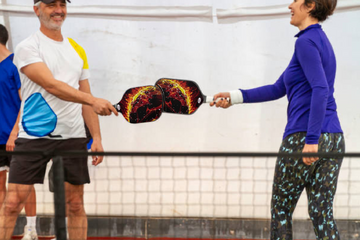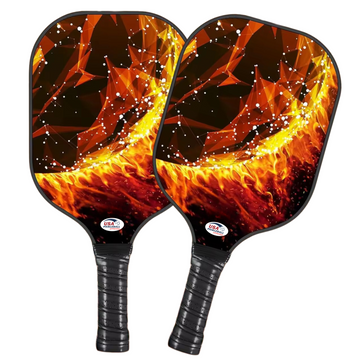Winning at pickleball doubles means working closely with your partner to cover the court and control the game. The best teams communicate well, know each other's strengths, and focus on strong net play to keep pressure on their opponents. Understanding when to move, when to attack, and how to support one another is key to outplaying the other team.
A good strategy also includes smart serving and returning, which can set up easy points. Teams that stay calm under pressure and adjust their plan during the game will have a better chance of winning. Success in doubles is about teamwork, positioning, and knowing when to be aggressive or defensive.
Key Takeaways
- Clear communication improves teamwork and court coverage.
- Controlling the net leads to more scoring chances.
- Adapting strategies during the match helps handle pressure.
Great doubles teams know: the right paddle isn’t just gear—it’s part of the strategy
Understanding Pickleball Doubles Fundamentals
Success in pickleball doubles relies on clear court positioning, well-defined partner roles, and consistent communication. Each player must know where to be and what to do at all times. Working together smoothly helps avoid mistakes and creates more scoring chances.
Doubles Court Positioning Basics
In doubles, players usually start side by side near the baseline during serves. After the return, partners move up to the non-volley zone line, creating an offensive position. Staying close to the net allows for quicker volleys and better control of the point.
Maintaining a diagonal formation helps cover the court evenly. If one partner moves forward, the other should cover back. Proper spacing prevents open areas the opponents can exploit.
Players should avoid crowding each other. It’s crucial to balance being close enough to cover short shots and far enough to protect the middle and backcourt.
Roles and Responsibilities for Partners
Each partner often shares both offensive and defensive tasks, but roles shift based on skill and style. Typically, one player takes more initiative at the net, hitting volleys and putting pressure on opponents.
The baseline partner handles stronger groundstrokes and lobs to keep the team in the point. Being ready to switch roles during play can improve flexibility.
Both players must return serves, cover the middle during rallies, and set each other up for winning shots. Knowing who will do what in certain situations reduces confusion and helps maintain steady play.
Communication Principles in Doubles
The perfect paddle makes the perfect partner—find your match and own the doubles court.
Clear communication is essential for avoiding collisions and choosing shots. Partners should use simple calls like “mine,” “yours,” or “switch” to indicate who will take the ball.
Talking after every point about what worked or didn’t helps adjust strategies. Non-verbal signals like hand gestures can guide positioning and intentions quietly during play.
Being positive and constructive in communication builds trust. It keeps both players focused and ready to support each other throughout the match.
Effective Partner Communication
Good communication helps players avoid confusion and cover the court better. It also builds trust and improves teamwork during fast-paced games.
Calling Shots and Coverage
Players should clearly call who will take each ball. This avoids both players going for the same shot or leaving a gap open. Simple words like “mine” or “yours” work well.
Calling out “left” or “right” helps direct the partner to cover certain areas. It’s important to speak loudly enough to be heard but not so loud as to distract.
When one player moves forward or backward, they should tell the partner. Saying “I’m up” or “cover baseline” lets the other adjust positioning. This keeps the team balanced.
Developing Nonverbal Signals
Nonverbal cues save time and keep communication smooth. Players can use hand signals behind the back to show planned shots or court positions.
For example, one finger can mean a soft shot, two fingers for a hard shot. A tap on the paddle may signal moving left or right.
Eye contact is also critical. It helps players quickly share information and confirm who will take the next shot without speaking.
Practicing these signals before matches makes them natural. This helps the team react faster during play.
Serving and Return Strategies
Serving and returning well sets the tone for the point. Both players must work together to control where the ball goes and plan their next shots.
Coordinating First Shots
Partners should decide who covers which side after the serve. The server aims for a deep and low serve to make it hard for opponents to attack.
The returner tries to send the ball to a weak spot, often deep and away from the net player. This forces opponents to hit a defensive shot.
Communication is key. Players might use signals or brief words to confirm their plan before the serve.
Targeting Opponents’ Weaknesses
Players watch for the weaker opponent, often targeting them with serves or returns. The goal is to force mistakes or weak replies.
If an opponent struggles with backhand shots, players aim there more often. They may also target slower players with faster balls.
Constantly changing where the ball goes keeps opponents guessing. This can create openings and reduce their confidence.
Setting Up Your Partner
The server and returner try to put their partner in a good position for the next shot. This means hitting to spots that allow the partner to attack.
For example, a server might serve wide to open up the court for their partner. The returner can hit to the open side, giving the partner an easy volley.
Good positioning after these first shots helps the team control the net and stay ready for quick exchanges.
Net Play and Kitchen Control
Controlling the area near the net and the kitchen line is a key part of winning in pickleball doubles. Success depends on good teamwork when moving and a strong, well-timed use of soft shots.
Moving as a Team at the Net
Players at the net should move together as one unit. When one player steps forward, the partner must adjust their position to cover the court effectively. This means staying side by side, about an arm’s length apart.
Communication matters here. Using short calls or signals helps prevent both players from moving into the same spot or leaving gaps. Both must keep low and ready, with knees bent, to react quickly to volleys or put-away shots.
Staying close to the net but not too close reduces the chance of easy returns from opponents. Good balance and quick, small steps allow fast shifts in position without losing stability.
Glide across the net as one—because the right paddle keeps you both in sync.
Mastering Dinks Together
Dinks are soft shots that land in the kitchen and are important for forcing weak returns. Both players should practice controlling dinks, aiming for precision over power.
Alternating dinks can create pressure by making opponents lift the ball, giving a chance to move in or attack. Players should keep dinks low and near the net line to limit easy rebounds.
It helps when partners can set up dinks in sequences, anticipating each other’s shots. This keeps opponents guessing and can open gaps. The goal is to keep the ball in play in the kitchen zone, wearing down the defense.
Defensive Tactics and Countering Offense
Strong defense in pickleball doubles means knowing when to slow down the game and how to move with your partner. These skills help players regain control and respond to aggressive shots.
Resetting the Point
Resetting the point means turning a difficult shot into a safe play. When under pressure, players should aim for deep, soft returns toward the opponent’s baseline. This stops the attack and forces the opponents to start their offense again.
Shot placement is key. Targeting the middle of the court or the opponent’s weaker side can reduce their options. Avoid risky shots like aggressive volleys when out of position.
Controlling the pace helps the team organize and prepare for the next shot. Using a dink or a lob at the right moment can slow the action and give partners time to recover.
Switching Sides Effectively
Switching sides quickly and smoothly is essential for good court coverage. When one player moves forward or backward, the other must shift to fill the space. This avoids open areas where opponents can't attack.
Communication is critical. Players should call out when changing positions. Signals or short words help avoid confusion during fast rallies.
The key moves during switching sides include:
- Diagonal shifts so both cover angles
- Clear lane movement to avoid crossing paths
- Watching the ball and anticipating opponent shots while moving
Practicing side switches builds teamwork and reduces gaps in defense. This limits opponent scoring chances.
Handling Pressure and Adapting Mid-Game
Staying calm and flexible during a match is key to managing tough moments. Teams that stay alert to changes in the game can shift their tactics quickly to keep control and reduce mistakes.
Making Strategic Adjustments
Players must watch their opponents closely to spot patterns or weaknesses. If a team struggles with fast serves, they might choose to stand further back to return more easily. Changing serve placement can also disrupt the other side’s rhythm.
Switching who takes the lead at the net or varying shot types, like mixing soft dinks with hard drives, can keep opponents off balance. Communication is critical; partners should briefly discuss what’s working and what isn’t before the next point.
Controlling Momentum as a Pair
Momentum swings can affect confidence and focus. When a team loses a few points in a row, they need to slow the pace. Taking deep breaths between points and resetting positioning can help maintain focus.
Celebrating small wins, like good serves or successful volleys, builds positive energy. Partners should support each other verbally to avoid frustration. Holding the net and staying aggressive can also prevent opponents from gaining momentum.
Common Mistakes and How to Avoid Them
The right paddle won’t fix everything, but it sure helps you avoid the usual slip-ups
One common mistake in pickleball doubles is poor communication. When partners do not talk or signal, they risk going for the same ball or leaving gaps on the court. To avoid this, teammates should use simple words or hand signals to coordinate their moves.
Another error is standing too close or too far apart. If partners are too close, they cover less area. If they are too far, they leave open space for the opponents. Finding the right distance helps cover the court effectively.
Many players hit the ball too hard or without control. This can lead to errors or easy returns for opponents. It is better to focus on placement and consistency rather than power.
Missing the chance to move up to the net is a frequent problem. Staying back too long lowers the team’s chances of winning points. Players should work together to move forward quickly after the serve or return.
|
Mistake |
How to Avoid |
|
Communication |
Use clear calls and hand signals |
|
Wrong positioning |
Keep a balanced distance to cover the court |
|
Hitting without control |
Focus on accuracy and ball placement |
|
Staying back at baseline |
Move up to the net as a team to apply pressure |


